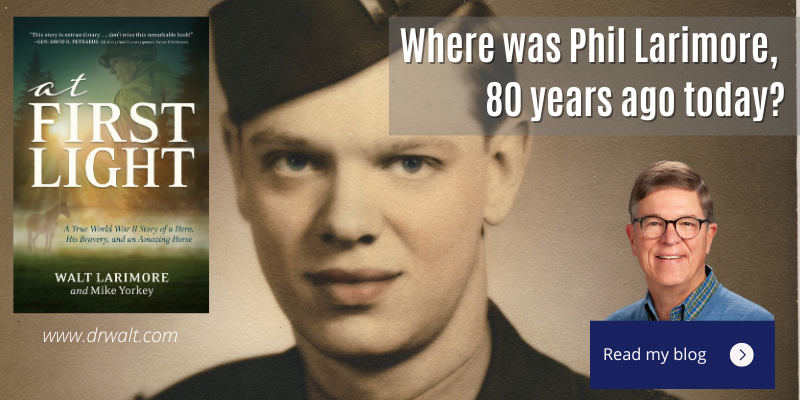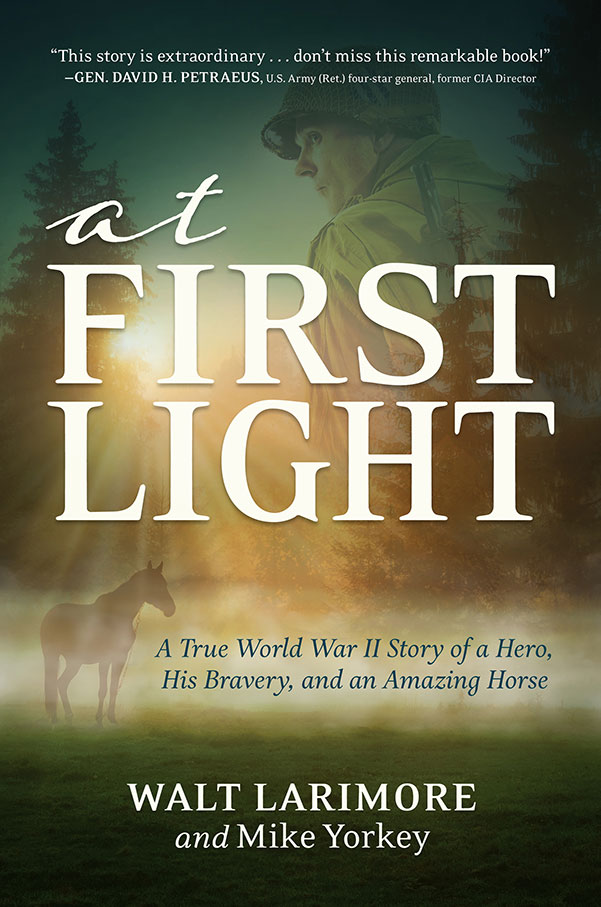
February 16, 1944 – A teenage WWII hero’s future units pinned down on Anzio
February 16, 2024
February 18, 1944 – A teenage WWII hero rides a master dressage stallion — Magellan
February 18, 2024After arriving on the docks at Naples, the ever-present Army 6×6 trucks were waiting to take Phil and the other second lieutenants to the Replacement Depot, which occupied a horse racetrack known as Italian Prime Minister Benito Mussolini’s favorite.

By early February, the German 14th Army surrounding Anzio numbered around 100,000 troops, while the Allied Forces totaled a fourth less at 76,400.
Both sides had suffered 20,000 casualties since the Allied landing on January 22, 1944, each loss needing at least one replacement.
Pulitzer Prize-winning historian and journalist Lawrence Rush “Rick” Atkinson wrote, “Casualties had become so corrosive that each U.S. infantry division in Italy could expect to lose its entire allotment of 132 2nd lieutenants in less than three months of combat.”
On average, 500 men were shipped from Naples each day to reinforce the so-called “Beachhead Army” of the U.S. VI Corps, led by Major General Lucian K. Truscott, previously the commander of the 3rd Infantry Division and one of the youngest division commanders in the U.S. Army at the time.
The first day or two after arriving, many of the officers took passes to go into Naples. But Phil had heard about some special horses being kept at the stables near the racetrack.
He and another officer, an equestrian who spoke fluent Italian, decided to explore the stables. Suspicious of criminals being present, they drew their sidearms and slowly moved from the door of one ornate stall to another.
At one stall, as Phil peered around the door, and a sudden short snort and sharp rap caused him to instinctively drop to one knee and aim his pistol at the potential enemy, using a two-handed combat pistol grip—ready to fire in an instant.
Standing in the stall was one of the most beautiful horses Phil had ever seen, prompting him to lower his gun. The horse’s head was small and a bit square, but his neck was elegant, long, crested, and high set. The stallion’s body was deep, his back short, and his powerful hindquarters round and wide.
A deep voice from behind surprised the men. “Cosa stai facendo qui? Tu chi sei?”
A thin old man rapidly approached them, holding a riding whip menacingly, pointing it at them.
“He wants to know what we are doing here and who we are,” Phil’s companion quickly translated.
“Well, hell!” Phil exclaimed, “Tell him we’re just looking around before he beats the tar out of us!”
A hasty conversation reassured the old stable master that the men were soldiers and equestrians. He put his whip down.
“Magellan,” the old man said in heavily accented English, “is his name.”
“I’ve never seen so magnificent a horse since I saw the Lipizzaners when I was a boy,” Phil replied.
“You were in Vienna?”
“No, sir. They were visiting in Tennessee where I grew up.”
The old man warmed to these comments. “Can you translate for me?” he asked Phil’s buddy, who nodded.
The old man began in Italian. “Magellan is one of the best examples of a rare breed—a Lipizzaner of the Neapolitan bloodline. We call them Neapolitans. They came from Spanish stallions bred with local mares of Etruscan and Berber ancestry back in Roman times. They became very popular in the old kingdom of Naples, but they almost became extinct until dressage changed everything.”
“Dressage?”
“It’s from an old French word that means training. It’s a way to teach a horse and rider to communicate and cooperate, an art in which the horse and rider work together to become two hearts with one mind. We who love dressage have a saying: ‘Ask me to show you poetry in motion, and I will show you dressage.’ It was during the Renaissance that it became an art, when the very first riding school in history was set up right here in Naples.”
“Here?”
“Si!” the old man emphasized. “In the sixteenth century. From this school came the world-famous Spanish riding school in Vienna 200 years later.”
“So that’s where the Lipizzaners I saw as a kid came from.”
“And that’s where most of the Lipizzaner breed is now housed—well, there and their stud farms. Hopefully, they will stay safe as I fear the war is heading toward them.”
Phil’s fellow officer asked, “Wasn’t there a dressage competition in the Olympics?”
The old man smiled. “Here in Italy, competitive dressage began at the beginning of the 20th century and was first included at the 1912 Olympic Games in Stockholm.”
Phil remembered reading about the Stockholm Games. “That’s the same Olympics where one of our generals, a hell-of-a-horseman named George Patton, competed in the first modern pentathlon.”
“Correct. In the 1912 Olympics, dressage was more of an obedience test derived from military tests and not well known,” the old man added, “but, by the 1936 Olympics in Berlin, the standard had risen dramatically. The sport is so refined now that a spectator cannot even see how the rider commands the horse.”
“So how do they communicate?” Phil’s friend asked.
“It’s very difficult to learn,” was all the old man would say.
Phil wondered if it was an insider’s secret. “I’d like to try. Is it possible?”
The man nodded. “Perhaps, but you must return tomorrow.”

In case you haven’t read or listened to Dad’s book, you can learn more or order it here.
© Copyright WLL, INC. 2024.




